Things We Learned at Primavera Sound 2013
In electronic music circles, Barcelona’s Primavera Sound festival is always likely to be slightly overshadowed […]
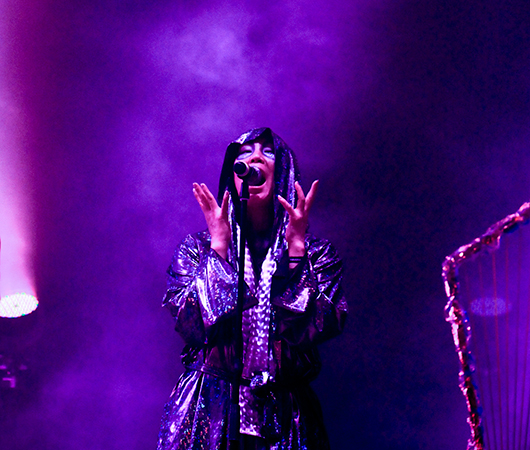
Things We Learned at Primavera Sound 2013
In electronic music circles, Barcelona’s Primavera Sound festival is always likely to be slightly overshadowed […]

In electronic music circles, Barcelona’s Primavera Sound festival is always likely to be slightly overshadowed by the presence of Sónar, which takes place in the same city just two weeks later. It’s a festival that shouldn’t be overlooked by dance fans though; despite a line-up that’s generally weighted more towards rock and indie, in the last few years Primavera’s electronic game has been surprisingly strong. Amidst the guitar bands are lengthy sets by some impressive DJ talent, on stages with great sound systems, alongside a solid selection of electronic and dance-tinged live acts. With that in mind, XLR8R made the trip over to the Catalan capital and spent a week investigating what the festival had to offer—and compiled a list of lessons we learned along the way.
Four Tet is probably on the best form of his career.
It’s hardly news that Kieren Hebden (a.k.a. Four Tet) is an exceptionally talented musician, but it feels like—both on record and as a live performer—the last couple of years have seen him enter something of a golden period. His recent live sets have been particularly special though, and true to form, his performance at Primavera Soun d2013 was like a master class in how live electronic music should be done. Each tune built and elaborated on its recorded counterpart without losing any of the intricacies of the original. Throughout his set, Hebden clearly worked hard to keep the pace up, building tracks into one another while walking a delicate line between energy and complexity. Tracks like “Plastic People” and “128 Harps” got the crowd moving with their mesmerizing melodic lines and crisp shuffling beats, but recent Nonplus cut “For These Times” was the clear highlight, with Hebden dragging out its storming drum breakdown to glorious effect. Despite playing the festival’s opening night, by the time things wrapped up with a gorgeous, crowd-pleasing rendition of “Love Cry,” it was already clear that Four Tet had turned in one of Primavera’s highlights.
The Knife (by Dani Canto)
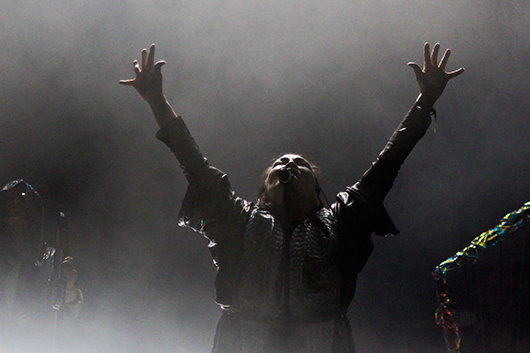
Despite what the internet might say, The Knife’s new live show is excellent.
It’s fair to say that The Knife‘s new Shaking The Habitual live show has received something of a mixed response from fans. When the Swedish duo—composed of siblings Karin Dreijer Andersson and Olof Dreijer—debuted the set in Germany back in April, it was met almost immediately with a tirade of online criticism, with complaints focused on the band’s overuse of backing tracks and the show’s emphasis on dance troupes rather than the duo themselves. In truth, while those criticisms aren’t entirely unfounded, they certainly seem unjustified. The Knife’s late-night headline set on the second night of Primavera was never not enjoyable, and felt like the perfect live realization of their excellent new record.
Accompanied by an entourage of back-up performers, the pair came onstage cloaked like Druids and proceeded to slowly unveil an assortment of peculiar percussion instruments. An elaborate harp, oversized chimes, and something that resembleed a futuristic coffin strung with a single, gigantic bass guitar string all appeared, which the band used to perform a fractured version of “A Cherry on Top.” Within a handful of songs, the instruments had been moved aside to make room for the dance troupe, who were now clad in colorful, over-the-top aerobics wear with Karin and Olof amongst them. During most of the tracks that followed, it was certainly debatable what, if any, of the music was being created by anyone on stage. The were times when it was just about possible to make out Karin performing her vocals cloaked in darkness at the back of the stage, and there were moments when Olof and the other performers would lurk near percussion instruments or disappear into the unknown completely.
That said, the choreography was excellent; the group flitted between precise formations and rhythmic freakouts, made pantomime displays of stretching between songs, and at one point mimed cunilingus in an impressively acrobatic fashion. There were immense amounts of humor and energy to the whole thing; whether The Knife were playing anything or not, they made the audience engage with the songs in a way that radiated an infectious liveliness. By the time “One Hit” was played midway through the set, the Primavera stage had been turned into something resembling a ritualistic warehouse rave. The set peaked with “Full Of Fire,” which, live or not, sounded immense on a big soundsystem, before climaxing further with a joyous version of “Silent Shout,” which saw Karin emerge from the shadows to perform her vocals centre stage. Ultimately, the whole thing came across as clever, completely unique, and quite possibly the perfect way for The Knife to represent themselves in 2013.
Jackmaster (by Xarlene)
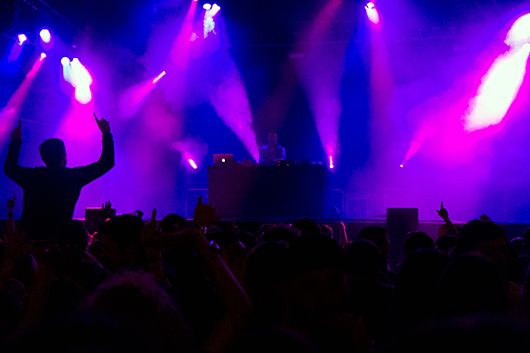
Jackmaster would make an exceptional wedding DJ.
On the surface, it would be easy to write off the Tweak-A-Holic set that Numbers co-founder Jackmaster played on the festival’s opening night as an easy win. He took to the Pitchfork stage at 3.30am and immediately dove into a set made up entirely of shamelessly retro, crowd-pleasing pop. He mixed Fleetwood Mac into Cyndi Lauper, threw out countless classic funk tracks, and milked ’80s pop tunes for all they were worth, unsurprisingly getting a huge crowd response throughout. In a way, it all felt a little like shooting fish in a barrel; an all-out voyage into pop nostalgia is essentially a guaranteed winner with a largely inebriated festival crowd during the early hours of the morning. However, there’s genuinely impressive DJ skill behind what Jackmaster does; when he suddenly cut from a live piano version of Prince’s “I Wanna Be Your Lover” into the original studio recording, it was a moment of crowd-pleasing brilliance, and there was something likeable about the way he stole the thunder from Daft Punk’s “Get Lucky” by playfully teasing “Music Sounds Better With You.” The whole set was utterly ridiculous, but it was hard not to be won over by it.
Scuba’s live show makes more sense on the edge of the Mediterranean at 3 a.m.
Scuba‘s new live set-up comes across like the final step in his transition from the basement icon of Triangulation into the divisive big-room house DJ we’ve seen with his latest releases. His stage set—which sees him performing amidst a fairly large, asymmetric scaffold of neon lights, encircled by a ring of colored searchlights and an intermittently illuminating backdrop—has clearly been designed from the ground up to hold the attention of big crowds. The same can be said for the music itself; Paul Rose’s festival set went in hard pretty quickly and left little room for subtlety. “The Hope” came out early and from then on, it was all about big beats and thick synth melodies. Over the course of his hour-long set, he touched on most of the bigger moments from his career—bringing out his remix of Jimmy Edgar’s “Sex Drive,” a version of “So You Think You’re Special” that descended into an extended outro of jungle breaks, and a double-header climax of “Talk Torque” and Personality‘s most rave-ready moment, “Ne1butu.” For all the bombast though, it worked perfectly for the situation. Despite clashing with some of the biggest draws of the festival and being up against an energy-sapped final night crowd, Rose got one of the most energetic reactions the Pitchfork stage saw all weekend. Sure, it was a colorful set full of big drops and hands-in-the-air melodies—the sort of thing we might struggle with a little in a normal club at home—but amongst the festival atmosphere, with our backs to the Mediterranean, we were happy to go along with the energy of it all.
Heineken Stage Crowd (by Dani Canto)
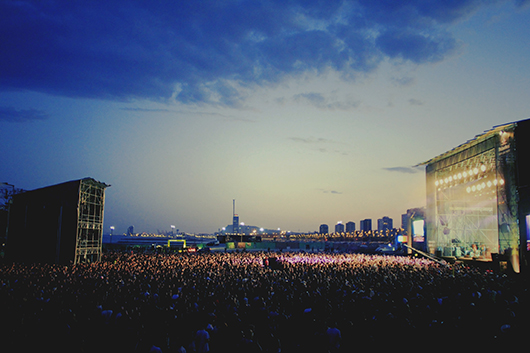
Daphni is an immensely fun DJ.
Dan Snaith’s 90-minute DJ set under his Daphni moniker, which closed the Ray Ban stage on Primavera’s second day, was easily one of the better DJ performances we’ve seen this year. It was a little all over the place at times—veering between big cuts from the likes of Koreless, Joy Orbison, and Four Tet into dusty old funk numbers, via a brief excursion into UK garage and grime (Ruff Sqwad’s “Together” being a particular highlight)—but the whole thing hung together, thanks to a welcome amount of energy and a pretty exceptional set of tunes. It was Snaith’s own Daphni tracks that received the biggest crowd response though; “Ye Ye” got the crowd moving, but it was an extended edit of “Yes I Know,” complete with its thunderous bassline, that really set the sizeable mass of late-night dancers alight. The whole thing ended with Snaith—clearly enjoying himself and possibly slightly inebriated—rinsing the EQs over extended funk instrumentals as the sun came up, before having to be pretty much dragged away from the decks by festival staff.
Barcelona has plenty of promising DJ talent.
Thursday’s Primavera Boiler Room session was a pleasantly surprising last-minute addition to the first day’s line-up. Taking the opportunity to kill a couple of hours in the early evening kicking about the Boiler Room area, which was tucked away in one corner of the festival site, we managed to catch some of the local Barcelona names on the line-up and were certainly impressed with what we saw. BeGun kicked things off with a lively outing built around energetic controller work that touched on everything from house to grime, while Headbirds followed with a slightly deeper set built of lovely early evening electronic music, his selections packed with rich synth vibes and solid grooves. Meanwhile, Madrid’s Pional rounded out the Spanish names on the bill, providing an early highlight with a killer set of solid house tunes in a relatively similar vein to his touring partner John Talabot. In all, we were left with the impression that there’s plenty of health amongst Spain’s current electronic scene.
Pional (by Xarlene)
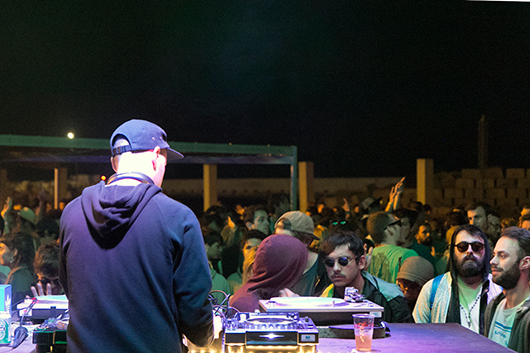
Primavera’s Auditori is the perfect setting for Apparat’s Krieg und Frieden.
The Auditori Rockdelux stage—a 3000-seat classical concert hall and museum—is one of Primavera Sound’s best features. While some festival goers bemoan the strict no-food-or-drink policy and the fact that audiences have to queue for some performances, the completely darkened, seated auditorium benefits from some of the most impressive acoustics we’ve heard at any venue. It’s here that Apparat performed his recent theater-inspired album, Krieg und Frieden, in its entirety, accompanied by a handful of musicians on strings, synths, and brass, and a pair of live visual artists. It was one of those performances where the venue enhanced the set perfectly; every musical element came through crystal clear, from the delicate string parts to some absolutely earth-shaking bass drones. The live visuals projected onto the the auditorium’s huge rear wall had the effect of making the band looked dwarfed by the huge imposing blocks of color and close-up imagery. The music itself was mostly enjoyable and engaging throughout, particularly the darker opening numbers, with each track flowing into one another to create one immense wash of droning synths and dark strings. However, as things got a little lighter and more beats and vocals seeped into the mix, the performance seemed to lose a little of its initial grittiness.
John Talabot’s victory lap is well deserved.
Primavera Sound 2012 saw local producer John Talabot perform his first-ever live show in the wake of his excellent debut LP ƒIN While that set felt a little like Talabot’s formal introduction to the international music circuit, the 2013 festival seemed to be something of a victory lap for him, with the DJ/producer returned to his home turf following the surprise success of that LP. He appeared twice across the festival, bringing his ever-superb live show to Wednesday night’s opening party and playing a DJ set to close the first day of the festival itself. The latter set saw him drop an excellent assortment low-key house and techno, peppered with moments of classic funk and soul, all mixed with deft, well-honed skill. More than anything though, it was just nice to see Talabot return to play to a substantial hometown crowd and claim his place as one of the most significant new names in modern house music.
Main Stage Crowd (by Xarlene)
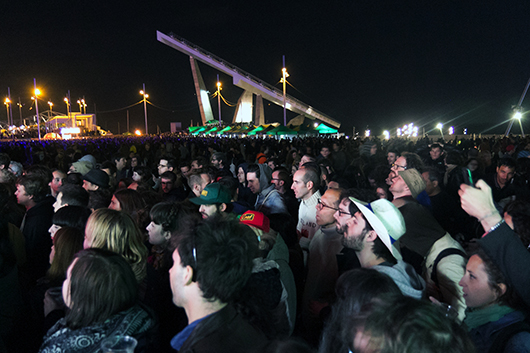
Primavera Sound is a very well-curated festival.
There are a handful of subtle things that set Primavera Sound apart from a lot of similar festivals we’ve attended. The variety of the line-up is one major factor that impressed us—while we approached the festival from the perspective of an electronic-music fan, it impressed us how expansive and deep the line-up was on the whole. Plenty of rock festivals include the odd token dance act—a category that’s usually limited to artists with some sort of crossover hit—but Primavera seems happy to go a little deeper, offering a genuinely interesting mix of artists from across the spectrum. Throughout the week, we found plenty to entertain ourselves with outside of our electronic comfort zone, including drone, ambience, hip-hop, and the more experimental ends of rock music. Crucially, the program is sensibly structured too; far too many festivals are happy to book a great house or techno DJ and stick them on at 2 p.m. when nobody’s is really ready to listen, whereas Primavera line-ups tend to be structured nicely with lighter, more experimental music in the early evening, big live acts later on, and the most danceable artists booked between 1 a.m. and sunrise. Sure, we had the odd minor organisation quibble—one of the bigger stages suffered fairly badly from sound bleed from its nearest neighbor, there was something of a trash problem, and some of the pre-parties were a nightmare to get into—but on the whole, our entire festival experience at Primavera Sound 2013 was very positive.

